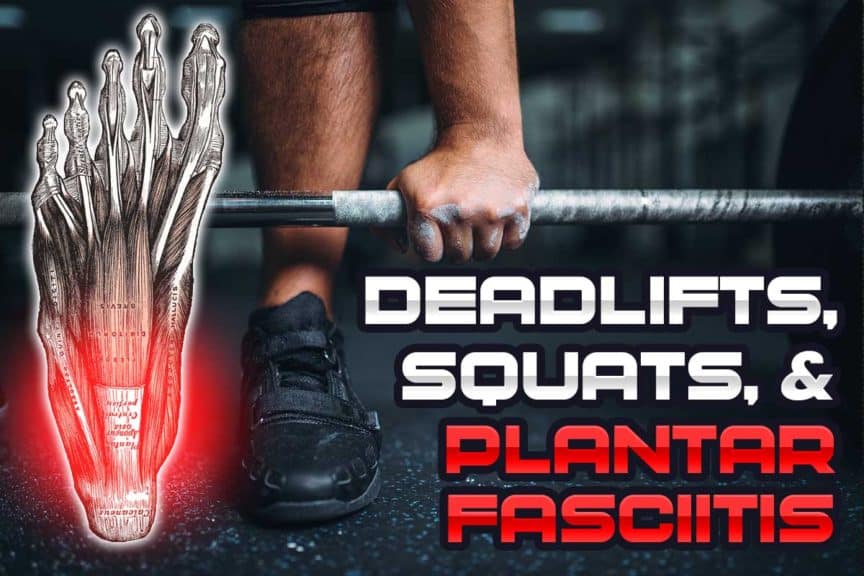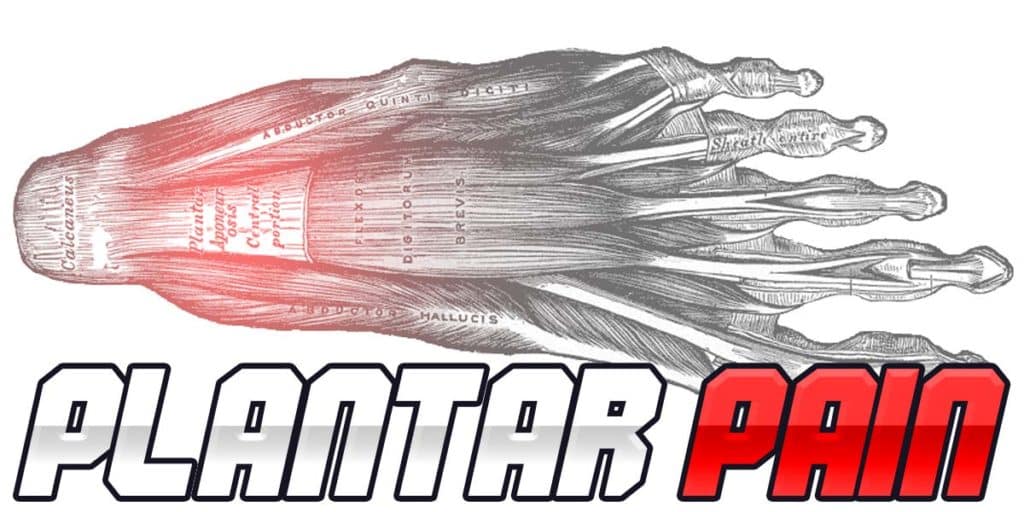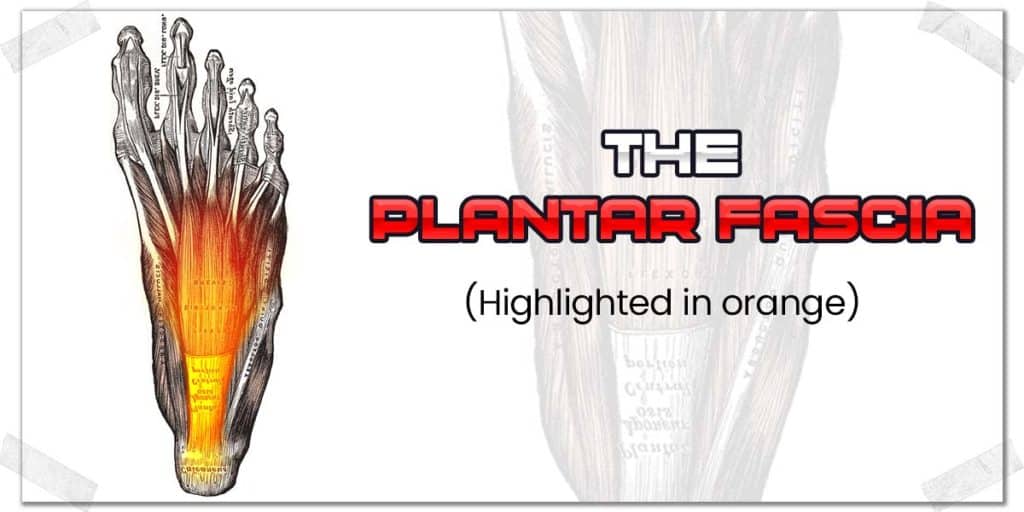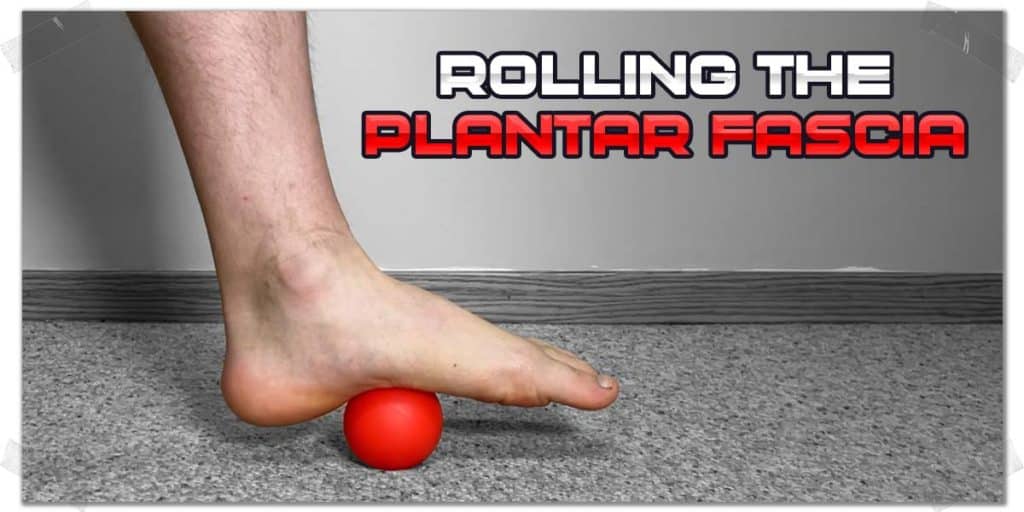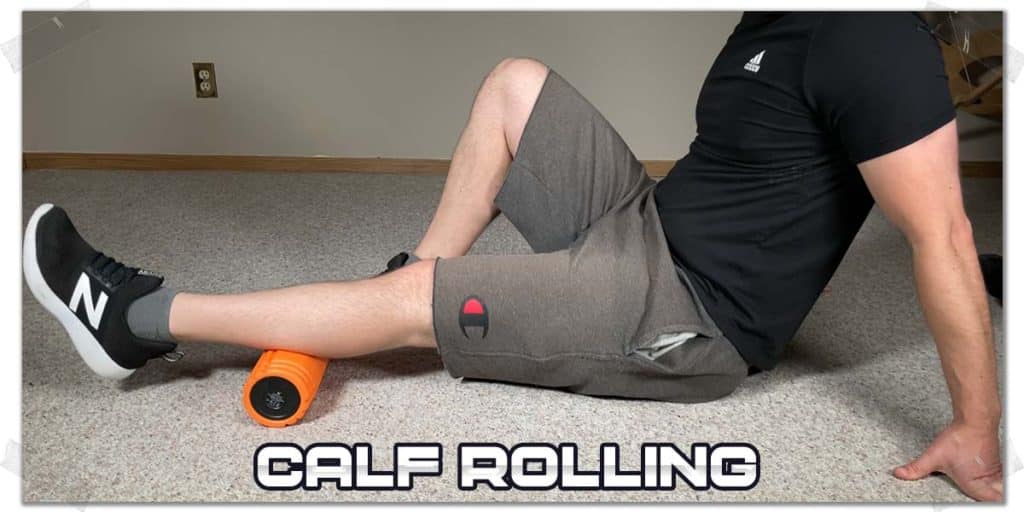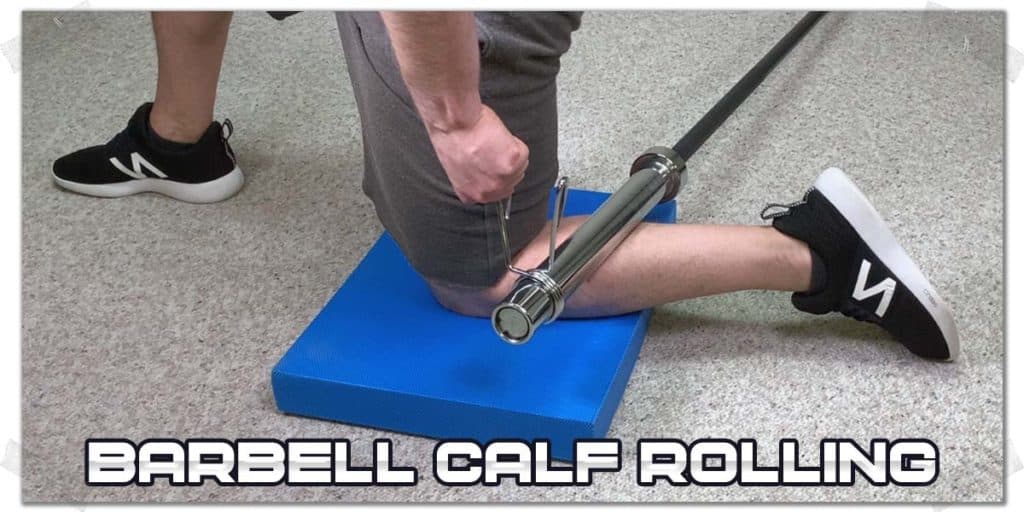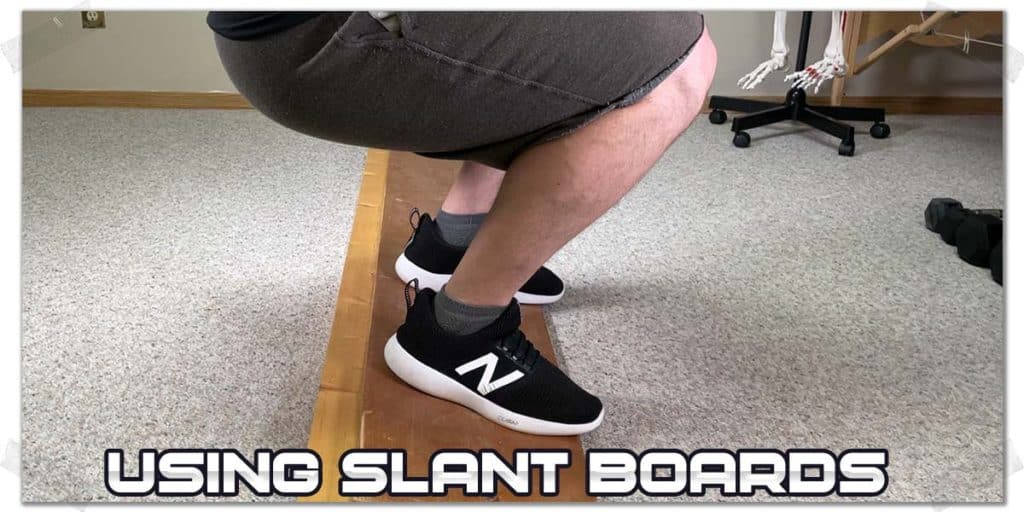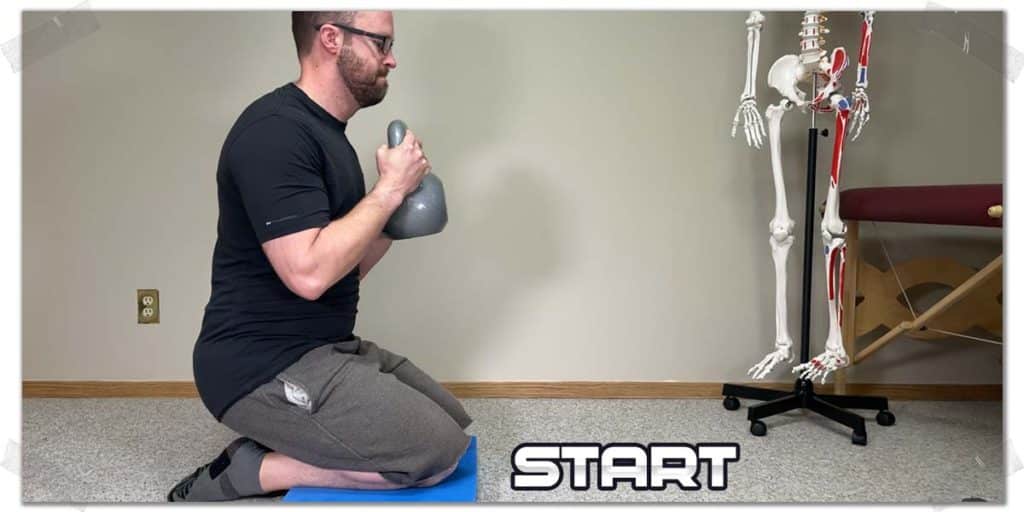Fun fact: the suffix “itis” refers to inflammation being present in an injury. But science is finding that the term “plantar fasciitis” (inflammation of the plantar fascia in the foot) is somewhat of a misnomer, as there’s actually not much inflammation present with this condition, which plenty of individuals aren’t aware of. So, this article just might be filled with updated, science-backed information many other blog articles aren’t mentioning when it comes to dealing with this incredibly frustrating condition.
Squatting and deadlifting with plantar fasciitis involves:
- Utilizing appropriate offloading interventions and preparation techniques before a workout.
- Modifying your lifts to reduce irritation to the affected area.
- Performing appropriate tissue treatment techniques after your workouts.
If you take the proper steps with all of this, it’s quite likely that you will speed up your recovery by minimizing further tissue irritation and avoiding pain flare-ups. As a result, you’ll miss fewer deadlifting and squatting sessions in the process. So, keep reading for the details.
Related article: Hip Hinge Hamstring Pain: Causes & Solutions Here’s What to do)
It should go without saying that when dealing with plantar fasciitis, seeking appropriate professional help is ideal, as a qualified physical therapist or another professional can provide targeted treatments that can drastically help. Additionally, a qualified professional will provide you with additional information that I’m not covering in this article (specific stretches, strengthening routines, etc.) However, I get that not everyone can afford or otherwise receive such treatment, hence this article.
To keep this article organized and easy to put into action, I’m categorizing the strategies and interventions into thee specific times of the day: before, during, and after your training or lifting session. On days when you’re not lifting, you can still utilize the in-gym workout strategies outside of the gym, if possible for you. But first, we need to quickly run through the basics of plantar fasciitis.
Plantar fasciitis: 101
We need to go over the basics of plantar fasciitis before getting treatment interventions and pain-reduction strategies. Stay with me here — the better you understand the nature of this condition, the more intuitive it will become regarding why you need to take specific actions while avoiding others. I’ll keep this quick and painless.
What plantar fasciitis actually is
The plantar fascia is a thick band of connective tissue on the bottom of the foot. It starts at the bottom of your heel bone (the calcaneus) and extends outwards along the bottom of the foot out towards the toes. It plays an essential role in helping to create stability within the foot, absorbing forces when walking and running, and assisting other biomechanical actions of the foot.
Plantar fasciitis, despite the “itis” in its name, is essentially a breakdown or degeneration of the fibrous bands (collagen fibers) comprising the fascia itself, without any notable markers of inflammation being present.1 This degeneration can occur for many reasons, but it tends to most often result from acute overuse in active individuals performing weight-bearing activities such as running, lifting, and sporting activities.2,3
While the condition can affect any area of the fascia, it most often affects the portion of the plantar fascia closest to the heel from where it originates.
Pro tip: Plantar fasciitis can take months to recover from, though it varies for many individuals. However, 90% of all cases resolve with conservative care and treatment.4
Why deadlifting and squatting are painful on your plantar fasciitis
Tissue that is irritated, degenerating, or otherwise unhealthy becomes extra sensitive to any forces that run through it or are placed upon it. In the case of the plantar fascia (which is unhealthy in this case), compressing it between the hard floor and your heel bone can be rather irritating.
To make matters worse, holding heavy weight in your hands during a deadlift or across your back during a loaded squat only adds to the amount of force compressing this already sensitive connective tissue, leading to increased discomfort or pain.
Additionally, this extra weight places greater downward force on the arches of the foot, which the plantar fascia helps to support. As a result, the plantar fascia is now stressed even further, leading to even higher levels of discomfort or pain.
Alright, with the basics of plantar fasciitis out of the way, let’s dive into the strategies you may want to implement.
Pre-workout strategies
Before you even step foot in the gym, there is a unique factor to consider and specific actions you can take, both of which can make a profound difference in how your plantar fascia will tolerate your squats, deadlifts, and other activities when you’re working out.
Key factor: The time of day
Plantar fasciitis often feels the worst with the first few steps you take in the morning since it can stiffen up quite noticeably overnight. It can also feel quite nasty in the evenings or at night after you’ve been walking or standing on your feet throughout the day.
As a result of these painful times of the day, scheduling your workout (if possible) somewhere between these timeframes might make a noticeable difference in terms of the perceived discomfort in your foot. I’d say it’s unlikely to make absolutely profound differences, but even if it knocks down the pain or discomfort by 10 or 20%, it could be well worth it.
Again, I realize it might not be possible to change the time of the day you work out, but if you can, it’s at least worth a try.
Action 1: Low-Dye taping
When it comes to minimizing stress placed on the plantar fascia, offloading the bottom of the foot through a specific taping application known as Low-Dye taping is your best bet. If there were only one pre-workout intervention to utilize, this would be the one (provided you use the ideal type of tape — see my article below).
This taping intervention is quick, easy to do, and has been shown within scientific literature to be statistically significant for reducing pain associated with plantar fasciitis.5
If you want the step-by-step breakdown of how to perform this technique, check out my article:
Plantar Fasciitis Taping: A MUCH More Effective Way (All By Yourself!)
Or, you can watch and follow along in my YouTube video:
Action 2: Preheating the fascia
A little bit of heat can go a long way when preparing the bottom of your foot to be more tolerant to any weight-bearing activities or exercises. By getting some heat into the bottom of your foot, you’ll not only increase circulation to this region, but you’ll also help reduce tissue stiffness, making the tissue more pliable (and thus tolerant) to stretch and other forces that run through the foot during workouts and other weight-bearing activities.
Heating the bottom of your foot and Achilles tendon (you’ll learn more about why to go after the Achilles in a bit) may not be overly practical for you if you’ve got a rather long drive to the gym or head there straight after work, etc. Still, if you can manage to make this work, you just might be surprised at how much this helps to reduce your pain during your workout. In the case of plantar fasciitis, warm tissue is happy tissue.
My personal suggestion would be to heat the bottom of your foot for a solid fifteen minutes and thereafter pop your sock and shoe back on to retain the heat and warmth as much as possible.
Personal insight: icing your plantar fascia is rather unlikely to produce any positive physiological effects for helping to heal the condition; all it’s likely going to do is stiffen up the tissue and make walking more painful while in its cold, stiffened state. Opt for heat instead.
During the workout
With all of the pre-workout factors considered and actions taken, once you’re in the gym, you need to keep the good stuff happening by:
- Performing a bit of soft tissue treatment
- Utilizing heel positions that will reduce plantar fascia stretch
- Modifying any of your squats or deadlifts if the pain is still too much
Let’s look at these factors in more detail.
Action 1: Performing soft tissue treatment
There are two areas you’ll want to target before diving into your squats and deadlifts:
- The plantar fascia itself
- The calf muscles (due to their fascial connection with the plantar fascia)
Performing targeted tissue treatment to these structures can dramatically improve how the plantar fascia tolerates a lower body workout – I’ve seen it numerous times with many of my patients and clients.
Let’s look at each of these in more detail.
Manipulating the plantar fascia
Giving the plantar fascia and other tissues on the bottom of your foot a bit of dedicated massage work before you start pushing and pulling some weight around can be as beneficial as it is simple to perform.
The easiest way to do this is to take a tennis ball, lacrosse ball, or another similar type of ball and slowly roll it around on the bottom of your foot with firm but tolerable pressure. This should not be a painful process — making it painful may only further irritate your foot.
Roll the bottom of your foot with enough pressure to feel your foot gently sink into the ball a little bit. The slower you go, the better. Do this for at least one minute. Discomfort is acceptable, but pain isn’t.
Pro tip: You can do this once you get to the gym just before your first exercise, and you can also opt to do it between sets or exercises if that’s practical for you to do.
Manipulating the fascia of the calves
While it initially might not make much sense to spend a minute or two targeting your calves before your lifts (since the problem is on the bottom of your foot, after all), it will make perfect sense once you become aware of the fascial connection between the calves and the plantar fascia itself.
Related article: The Seven Best Ways to Massage Your Calf Muscles All By Yourself
When it comes to fascia (the tissue that wraps and covers your muscles), your body is wired in some really unique ways; fascia travels in a linked chain across multiple groups of muscles. These are often termed fascial trains or fascial meridians, popularized by Thomas Myers.
The particular fascial chain we’re interested in for this particular scenario is the superficial back line. This train of tissue runs from the bottom of the foot, through the Achilles tendon, up through the calves, into the hamstrings, and up the deep stabilizing muscles of the back, all the way to your skull.
Since the calves are directly next door to the plantar fascia itself and are linked through the same train or meridian, manipulating the fascia around the calves can dramatically offload tension and reduce discomfort in the plantar fascia.6,7
I’m not the world’s greatest physio by any stretch of the imagination, but I have plenty of patients who sometimes think I am after dramatically reducing their plantar fasciitis pain by performing soft tissue work on their calves. It’s pretty fun to see how amazed they often are with how much better their foot feels after some soft tissue treatment to the calves.
Here’s how to mobilize the fascia of the calves all by yourself:
- METHOD 1: Grab a foam roller or firm medicine ball and slowly roll the roller or ball over top of your calves using moderate pressure for at least one minute. You want to use enough pressure and a firm enough roller or medicine ball for it to be a strong but tolerable sensation of discomfort.
- METHOD 2: Grab a barbell and place the sleeve on your calf, as shown in the picture. Slowly roll the barbell sleeve up and down the belly of your calf muscles (do not do this over the Achilles’ tendon, which is below the muscle belly).
Using a barbell can feel excruciating, so it may not be appropriate for you. But, if you can gut it out, it can make profound differences in reducing any latent myofascial trigger points in your calves (which pretty much everyone has).
Action 2: Utilizing heel positions that will reduce plantar fascia stretch
This action is all about changing the angle at which your ankle is positioned when standing, walking, deadlifting, squatting, etc. When your ankles are pointed downwards (known as plantarflexion), your plantar fascia experiences less physical stretching and tension during these activities.
Changing the angle of the ankle in a way that lessens the stretch to the bottom of the foot can yield profound differences since irritated, unhealthy tissue is often highly sensitive to being stretched, leading to pain, irritation and ultimately, a prolonged recovery.
The best way to offload the stretch to the bottom of the foot is to use one or more of the following:
- Placing a heel cup within your shoe.
- Standing on external heel wedges or angled surfaces when performing your squats, and potentially with your deadlifts (it can depend on a few specific factors for the deadlift).
- Wearing weightlifting shoes (if you have a pair).
All of these interventions will raise the heel upwards (increasing ankle plantarflexion), which shortens the resting position of the calf muscles and Achilles tendon while simultaneously reducing the amount of physical stretch placed on the plantar fascia.
Pro tip: if you use a heel cup, you can wear this in your shoe throughout the day in addition to wearing it while in the gym performing your squats and deadlifts.
If you have weightlifting shoes, you likely know that these essentially have a heel cup or wedge built in. Keep these shoes on for all your primary and accessory lifts. While advanced lifters may not want to perform heavy deadlifts in weightlifting shoes, this is really only an issue with heavy, near maximal lifts — which you likely won’t be doing if you’re battling plantar fasciitis.
If nothing else, I would seriously recommend getting a heel cup in your shoe. You can pick one up at the local pharmacy for only a few bucks, and they can significantly reduce discomfort in the plantar fascia region.
If a heel cup isn’t in the cards and you don’t own a pair of lifting shoes, your next best bet is to elevate your heels on some small weight plates or stand on some block wedges when you perform your squats and deadlifts. Doing so will keep your ankles in a plantarflexed position, which will offload the amount of stretch running through the bottom of your foot during your lifts. You can also wear a heal cup while simultaneously standing on wedge blocks or elevating your heels on a board.
Again, I wish to stress that I’m well aware that having elevated heels during a deadlift isn’t ideal for lifting heavier loads from a performance standpoint. Still, for this particular scenario, if it helps reduce your discomfort to the point that it allows you to deadlift, the end justifies the means. Besides, you won’t be doing this forever.
Action 3: Modified exercises
If you can’t find a way to make your squats or deadlifts manageable (despite your best efforts), don’t fret. You can opt to try some other great movements that will challenge the same group of muscles for these lifts, but likely without loading and stressing the plantar fascia as aggressively (or at all).
Using open chain exercises
If your plantar fasciitis flares up to the point where you can’t even bear the thought of putting any weight through your foot or heels, finding additional exercises you can perform while keeping your feet off the ground is your primary solution.
Leg exercises that keep your feet off the floor or off of a contact surface are known as open chain exercises. These exercises will allow you to train your leg muscles without placing any load or stress onto your plantar fascia.
Traditional lower body open chain exercises you could opt for include:
- Leg extensions
- Prone or seated hamstring curls
Obviously, there are numerous open chain exercises you could opt for, depending on what equipment you have access to.
Additional open chain exercises you could perform without any specific machine equipment include:
- The stability ball triple threat (see the video thumbnail below)
- Bent-knee supine hip extensions with a chair (Youtube video)
- Quadruped glute kickbacks
- Reverse Nordic curls
Related article: Six Practical Benefits of Reverse Nordic Curls (Are You Missing Out?)
Or, if you want to spend a bit of money, you could pick up a MonkeyFeet from Animalhouse Fitness and perform all sorts of open chain exercises using resistance without placing any load through your foot. I have no affiliation with this company; I’m just a big fan of this little device.
Specific open chain exercises
If you’re keen on replicating squatting and deadlifting patterns, you can opt to try the following two exercises. Each replicates specific demands of the squat and deadlift without putting any load or weight through the plantar fascia — just make sure your knees don’t give you any grief in the process.
I often give these exercises to my patients who are limited in their ability to squat or deadlift due to plantar fasciitis pain. Give them a try if you think they might be worth implementing for replacing your squats or deadlifts for the time being.
Kneeling goblet squats
The kneeling goblet squat can be a deceptively challenging lower body exercise and one that’s perfect for performing when you simply have too much pain to be standing on your foot. It’s near equally hip dominant in its movement as it is knee dominant, making it an exercise that mimics the lower body demands of the standing squat. Just make sure that this kneeling position doesn’t bother your knees.
All you have to do is grab a heavy weight (dumbbell or kettlebell) and hold it at your chest while rocking back onto your heels, then rise out of the position to return to a fully straight position (see photos). Give your butt a big squeeze each time you rise up. You’ll feel your glutes and quads work each time you rise upwards.
Kneeling banded push-throughs
The kneeling banded push-through is the perfect exercise to perform if you can’t deadlift from your feet (due to pain) but need to fire up your glutes, hamstrings, and lower back in a hinging pattern similar to the deadlift. It’s much like the kneeling goblet squats but forces you to push through an accommodating resistance (i.e. a band). This is a deceptive exercise — trust me!
You will need some sort of squat rack or squat stands that you can anchor the band on. If you don’t have access to this, just sick with the kneeling goblet squats. Make sure to use an appropriately thick band for your own strength and abilities.
Pro tip: Want to really light yourself up? Perform this exercise while holding onto some weight as you would with the kneeling goblet squat.
After the workout
Assuming you want to get your plantar fasciitis under control as quickly as possible, you need to continue to look after your foot for the rest of the day — not just before and during a workout. Thankfully, doing so isn’t rocket science; just be smart with things and make sure you’re following the general points below (at a minimum).
Here are some important considerations to keep in mind:
- If you had an aggressive workout and find that your foot feels a bit irritated after the workout, you haven’t damaged anything (assuming it’s only a mild increase in pain or discomfort) — you’ve likely just irritated the tissue a bit. If this is the case, try to be mindful of how much walking and standing you do for the rest of the day.
- Keep your Low-Dye tape on your foot (assuming you used Leukotape) if you taped it before your workout. If you didn’t, taping it after your workout might feel rather amazing in terms of the offloading it can provide.
- If need be, you can re-tape your foot if you find the tape isn’t feeling as effective as it did before your workout.
- Continue with soft tissue treatment techniques to your calves (mainly through rolling or massages) and to the bottom of your foot (as long as it feels appropriate for you).
- Make sure you modify your other fitness activities and daily pursuits in ways that help to minimize or eliminate the amount of force and discomfort you’re putting through your foot. The more you effectively look after your foot by modifying your other daily activities, the more it will likely be able to tolerate for your deadlifting and squatting.
- See if you can get at least one or two sessions with a qualified specialist who can help show you further specific stretching exercises and strengthening exercises for your foot and lower leg.
Final thoughts
Plantar fasciitis can take some dedicated time and effort to fully resolve; however, nine out of ten individuals make a full recovery with conservative measures alone. If this condition is making it difficult to squat or deadlift (or both), take some time to try out the tips in this article while applying them in ways that are appropriate for you.
The ultimate goal is to find a way to keep pulling weight off the floor and keep pushing it up towards the ceiling. You can’t do that when you’re limited by overwhelming pain. Be smart about this; get a professional to help treat the condition and work with you while you take the time to dial in strategies that work best for you.
References:

Hi! I’m Jim Wittstrom, PT, DPT, CSCS, Pn1.
I am a physical therapist who is passionate about all things pertaining to strength & conditioning, human movement, injury prevention and rehabilitation. I created StrengthResurgence.com in order to help others become stronger and healthier. I also love helping aspiring students and therapists fulfill their dreams of becoming successful in school and within their clinical PT practice. Thanks for checking out my site!

